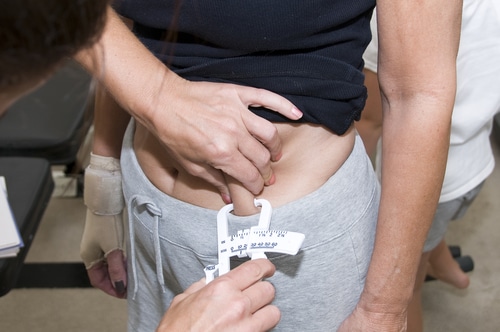
Are Skinfold Calipers Accurate?
There are more accurate ways to measure body fat percentage including hydrostatic weighing and using a DEXA scan, but these methods are too time-consuming and expensive to be practical for the average person. Another alternative is to purchase a body fat scale. Although not as accurate as hydrostatic weighing or DEXA, body fat scales are useful for monitoring changes in body fat composition. They use the principle of bioelectrical impedance to calculate body fat. This involves sending a weak electrical current from one foot to the other while you stand on a scale. The current moves faster through muscle than through fat. Based on speed, the scale calculates an approximate body fat percentage. A body fat scale is also more expensive than skinfold calipers.
Measuring Body Fat with Skinfold Calipers
Skinfold calipers are designed to measure the thickness of fat folds in millimeters. To use them, you grab a fold of skin in a particular area and hold it between your fingers. You then attach the caliper clamps to the fold while holding it and note the thickness in millimeters.
To increase the accuracy of the measurement, measure folds in four different locations – the back of the arm, the front of the arm, the back below the shoulder blade and the waist. Some experts suggest measuring folds at up to seven different sites to get a more accurate measurement. They also recommend repeating the measurement three times at each site and taking an average of the values. To get body fat percentage, add up the measurements from each site, and refer to a standard chart. There are separate reference charts for men and women. To be consistent, it’s important to take measurements from the same sites every time.
Are Skinfold Calipers Accurate for Measuring Body Fat?
There’s room for human error using this technique. The results can be altered by how much pressure you apply when grabbing and holding the skin. It’s important to pinch with equal pressure at each site. Skinfold calipers also can’t measure visceral fat, the unhealthy type of fat that lies deep within the pelvis and increases the risk of health problems like heart disease and type 2 diabetes.
All in all, calipers provide a reasonable estimate of body fat percentage if you measure from the same sites and use consistent amounts of pressure when holding the skin. Good technique is important for accuracy. Measure at the same time of day every time, and avoid taking measurements immediately after a workout. Skinfold measurement isn’t as accurate as underwater weighing or a DEXA scan, but it’s a good tool for following changes in body fat percentage if the measurer uses consistent technique and takes measurements at the same time of day each time.
Body Fat Scales vs. Skinfold Calipers
Body fat scales are also not extremely accurate in an absolute sense, but they’re fairly reliable for measuring changes in body fat percentage over time. The readings can be affected by factors such as temperature, damp or wet feet, and hydration status. Although body fat scales suffer from a lack of absolute accuracy like skinfold calipers, they’re easier to use and less prone to operator error.
The Bottom Line?
Skinfold calipers are an inexpensive way to roughly determine body fat percentage. Despite their lack of absolute accuracy, they’re useful for following changes in body fat percentage over time. A body fat scale offers more convenience, so it’s a good alternative for people who don’t mind paying a little more money.
References:
J Am Diet Assoc. 1994 Aug;94(8):855-8.
The Nutritionist. Robert Wildman, Ph.D., RD. 2002.
Related Articles By Cathe:
3 Tests that Outperform BMI for Monitoring Obesity & Health Risks
Why BMI is Not a Good Measure of Obesity in Women After Menopause
What’s the Best Way to Track Your Body Fat Percentage?
What’s a Healthy Body Fat Percentage for Women?
How Effective Are Skin-Fold Measurements for Determining Body Fat Percentage?
Body Weight, Bmi, Waist Size – Which is the Best Indicator of Health?

